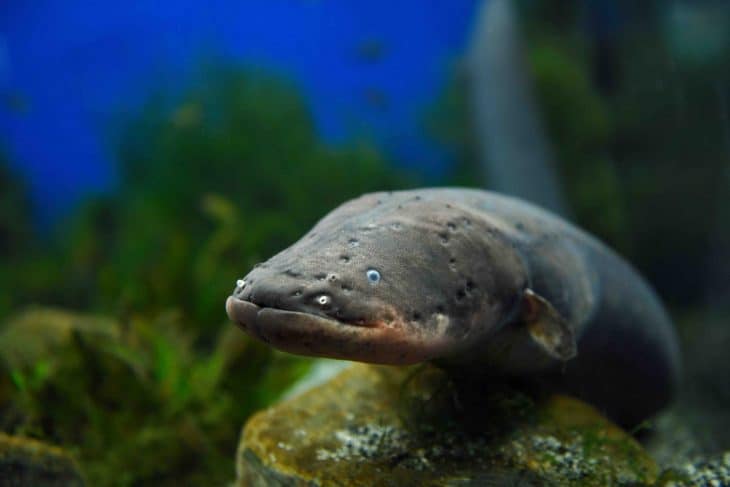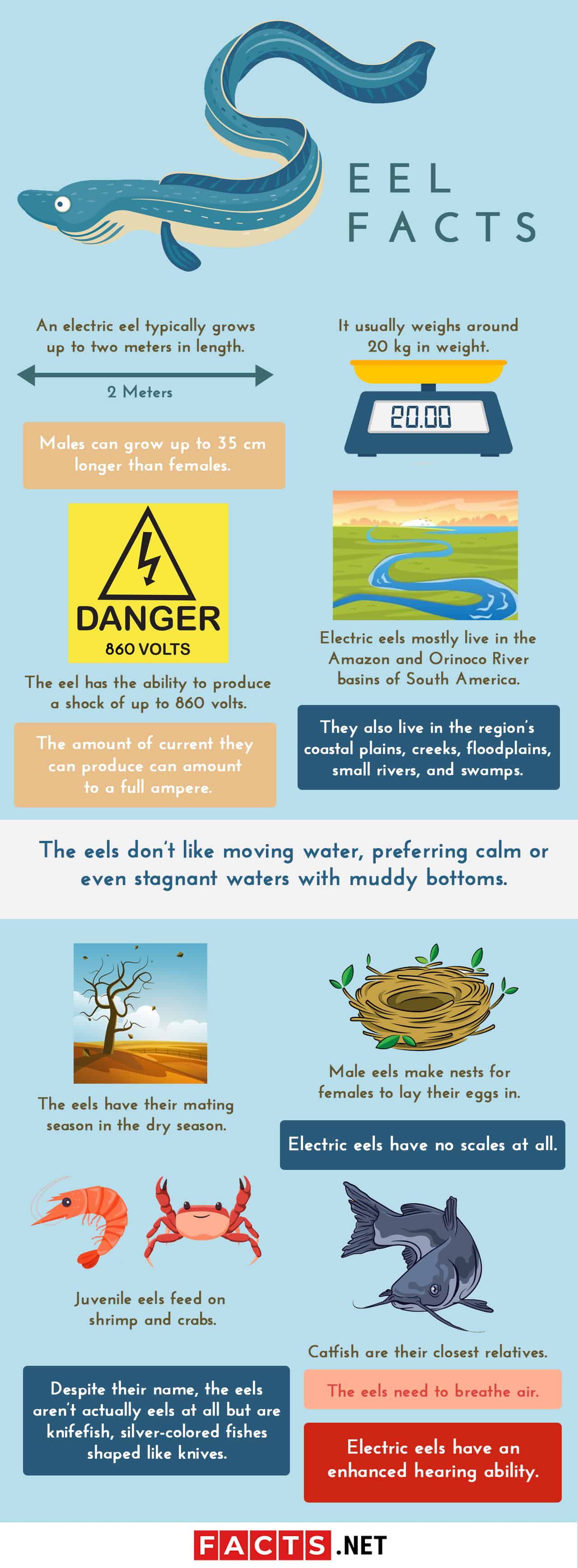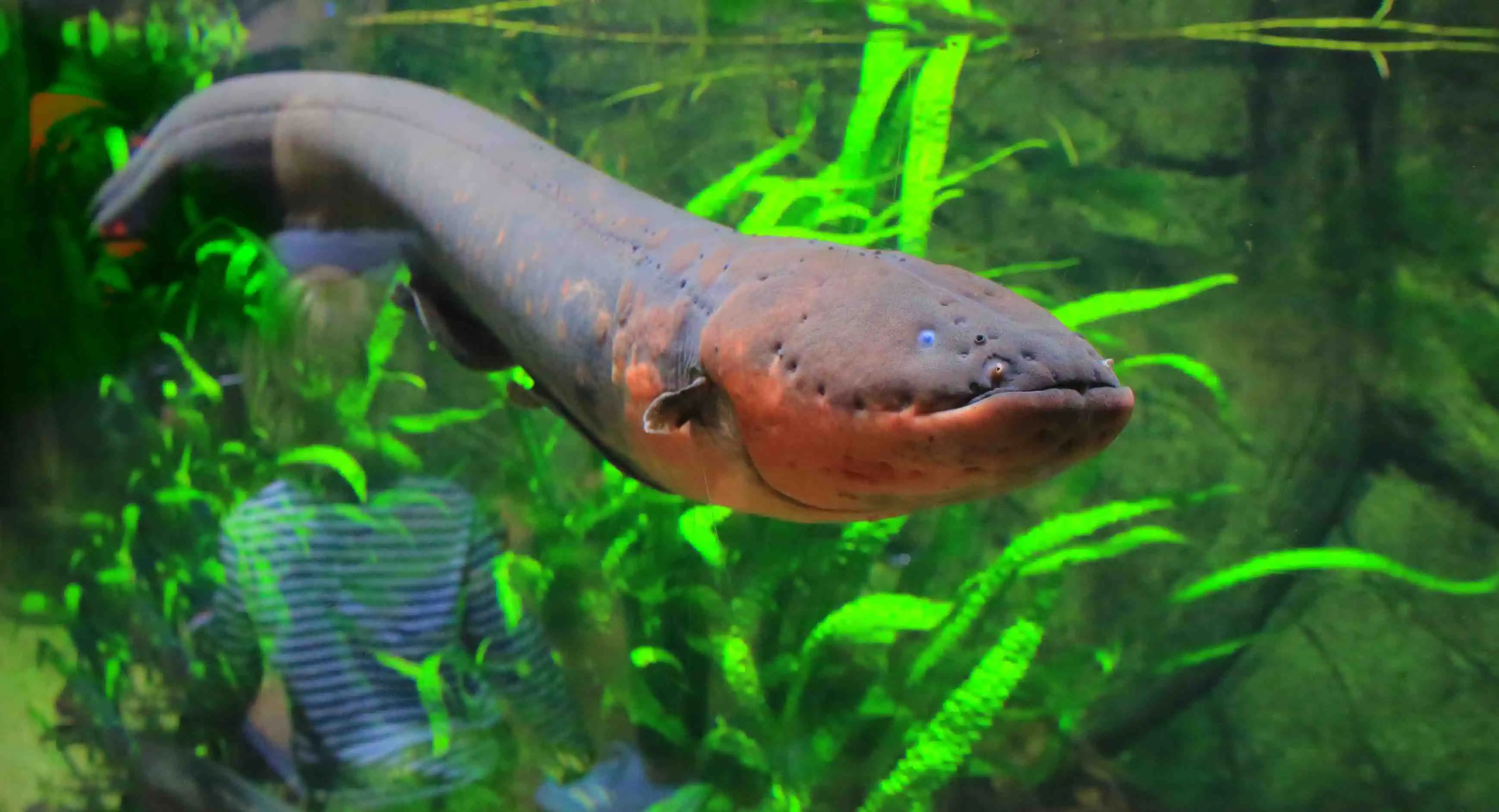
Electric eels are not the most common animals in the world, but that fact doesn’t make them less important than other creatures of the sea. If truth to be told, the rarity of their species makes them among the most well-known fish species in the world.
There are about recorded 800 eel species today. Among that list, Japanese eels are currently classified as endangered — owing to habitat loss, overfishing, and other factors. The European eel belongs in that category, too. The overall number of European eels in the world decreased by around 90% since the 1970s. Electric eels are well-known for their ability to produce a strong electric shock to predators and prey. But did you know that eels can generate a shock of up to 860 volts? That’s up to 1 ampere of current!
If someone serves you eel, you better eat it! Eels are very nutritious. In Japan, it’s widely believed that eels give you vitality. While they are friendly when served as a dish, you better swim away from them if you see them while scuba diving. Why? An electric eel’s shock is similar to a stun gun’s brief but numbing jolt. Normally, a person cannot die from a single shock. Multiple shocks, however, can cause heart or respiratory failure. The most common cause of death from electric eels shocks is drowning as the jolt can knock a person unconscious. If you are in the water a lot, you still shouldn’t worry too much about it as you won’t most likely encounter them. Electric eels live in a small area of the world and are difficult to keep in captivity, so most people have never seen one.
Did our quick rundown of eel facts make you want to know more about these wonders of nature? Then check out our 30 electric eel facts below!
- An electric eel typically grows up to two meters in length.
- Males can grow up to 35 cm longer than females.
- It usually weighs around 20 kg in weight.
- The eel has the ability to produce a shock of up to 860 volts.
- The amount of current they can produce can amount to a full ampere.
- Electric eels mostly live in the Amazon and Orinoco River basins of South America.
- They also live in the region’s coastal plains, creeks, floodplains, small rivers, and swamps.
- The eels don’t like moving water, preferring calm or even stagnant waters with muddy bottoms.
- The eels have their mating season in the dry season.
- Male eels make nests for females to lay their eggs in.
- Females can lay up to 3,000 eggs in a single nest.
- Eels eat unhatched eggs and smaller eels.
- Juvenile eels feed on shrimp and crabs.
- Once they become adults, the eels feed on fish and small mammals like rats.
- The eels can live for a long time, up to 22 years in captivity, even.
- Electric eels have no scales at all.
- Despite their name, the eels aren’t actually eels at all but are knifefish, silver-colored fishes shaped like knives.
- Catfish are their closest relatives.
- International organizations put the eels in the category of Least Concern. This means they won’t be extinct anytime soon.
- The eels tend to have a dark-brown color on their backs, but yellow or orange on their bellies.
Electric Eel Facts Infographics

Electric eels have a turbulent history.
Specifically, their scientific name experienced many revisions over the centuries. Carl Linnaeus first gave them the name Gymnotus carapo or banded knifefish in 1766. Centuries later in 1864, Theodore Gill renamed them Electrophorus electricus, which are used today. Scientists later considered giving the species its own family, the Electrophoridae, but ultimately kept them in the Gymnotidae family. In 2019, scientists led by David de Santana proposed reclassifying some electric eels into 2 new species. These are the Electrophorus voltai and the Electrophorus varii, based on differences in anatomy, DNA, habitat, and more.
The eels need to breathe air.
This results from the fact that they have no gills, instead they have buccal cavities as most amphibians have. This means electric eels have to periodically surface, usually around every 10 minutes, in order to breathe before returning underwater.

Electric eels have an enhanced hearing ability.
Scientists call it the Weberian Apparatus, where a gas chamber inside the fish has a connection to their inner ears made up of a series of small bones. The gas chamber helps keep the fish in control of its depth in the water and amplifies any sounds it might pick up. The bones then vibrate in the same way the sounds do in the air and directly transmit those vibrations to the inner ear. This, in turn, allows the electric eel to hear much better than it otherwise could.
They also have three separate organs to generate electricity with.
There’s the main organ, which runs along most of the eel’s back, and Sach’s organ, which are found on the back of an eel’s tail. Finally, there’s Hunter’s organ, which is seen along an eel’s entire belly. Electrocyte, or electrical cells, make up all three organs and work in a similar way to nervous systems generate and transmit electrical signals. An electrical eel’s body stacks the electrolytes, allowing them to charge up a powerful electrical shock when needed.
Electric eels can also control the amount of electricity they produce.
Amazingly, electric eels can control how much electricity they would want to conjure. Low voltage shocks let the eel sense their surroundings while high voltage shocks are used to hunt prey. They can also gauge how much electricity they can put out per unit of time. An electric eel puts out high voltage pulses every 2 milliseconds for starters, which causes prey to expose themselves. They then put out 400 high voltage pulses in a single second to stun and paralyze their prey, allowing them to finally bite down.
They also use electricity to hunt others of their kind.
Eels also have the ability to sense electricity emitted by other electric eels. They do this using patches of high-frequency tuberous receptors that lie scattered across their bodies. Talk about some electrifying eel facts!

Michael Faraday used electric eels in his experiments.
An English scientist from the late 18th to late 19th centuries, Michael Faraday pioneered the study of electromagnetism and electrochemistry. Over a period of four months, Faraday carefully measured and recorded the electrical pulses eels generated. These experiments allowed Faraday to measure the power and direction of the pulses. With the help of a galvanometer, Faraday was able to prove beyond question the eels’ ability to produce electricity.
Modern scientists have considered copying the eel’s framework for inventions.
In particular, they think artificial power cells that use the same design as the electrolytes of an electric eel can find use in small applications. These include medical implants like pacemakers and also even micromachines.
It’s not easy to catch electric eels.
This comes from the fact that the only way to capture eels involves tiring them out. Hunters have to force the eels in the wild to repeatedly discharge into the water until they’re too tired to keep going. Only then can the hunters safely go into the water to get the eels.
The Tennessee Aquarium in the USA has an eel.
They call him Miguel Watson and have him remotely hooked up to a small computer. Every time Watson generates a powerful electrical pulse, the said computer sends out a pre-written tweet notifying everyone about his pulse.
Was this page helpful?
Our commitment to delivering trustworthy and engaging content is at the heart of what we do. Each fact on our site is contributed by real users like you, bringing a wealth of diverse insights and information. To ensure the highest standards of accuracy and reliability, our dedicated editors meticulously review each submission. This process guarantees that the facts we share are not only fascinating but also credible. Trust in our commitment to quality and authenticity as you explore and learn with us.


